ART NEWS: June 03
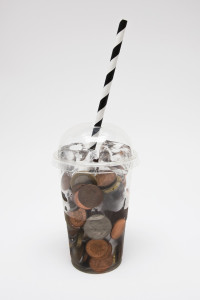 Shedhalle Zürich’s concept PROTOZONES 2020–2025, developed an exhibition model that focuses on “process-based art,” which presents accessible and sustainable practices through high and low intensity phases. “Protozone, You’re So Busy”, will develop throughout its seven weeks, accumulating and filling the space with traces of processes developed both previous to and during the Protozone. Each project focuses on care and radical love, prioritizing horizontal organizational structures that remain porous, allowing audiences various points of entry and engagement. Exploring new ways of exhibiting artistic processes, building inclusive communities, and experiencing time in the exhibition space. The exhibition attempts to refocus our eyes from screens, walls and windows back to one another. Bringing together performers, writers, activists and artists, this Protozone proposes itself as a catalyst for new ways of thinking and spilling outside the institution, into our daily lives. Participating artists: Army of Love (Alexa Karolinski/Ingo Niermann), Débora Delmar, Pierre Huyghe, Nikima Jagudajev, Krõõt Juurak, Autumn Knight, OFFSHORE, Tino Sehgal. Info: Shedhalle Zürich, Rote Fabrik, Seestrasse 395, Zürich, Switzerland, Duration: 11/6-25/7/2021, https://shedhalle.ch
Shedhalle Zürich’s concept PROTOZONES 2020–2025, developed an exhibition model that focuses on “process-based art,” which presents accessible and sustainable practices through high and low intensity phases. “Protozone, You’re So Busy”, will develop throughout its seven weeks, accumulating and filling the space with traces of processes developed both previous to and during the Protozone. Each project focuses on care and radical love, prioritizing horizontal organizational structures that remain porous, allowing audiences various points of entry and engagement. Exploring new ways of exhibiting artistic processes, building inclusive communities, and experiencing time in the exhibition space. The exhibition attempts to refocus our eyes from screens, walls and windows back to one another. Bringing together performers, writers, activists and artists, this Protozone proposes itself as a catalyst for new ways of thinking and spilling outside the institution, into our daily lives. Participating artists: Army of Love (Alexa Karolinski/Ingo Niermann), Débora Delmar, Pierre Huyghe, Nikima Jagudajev, Krõõt Juurak, Autumn Knight, OFFSHORE, Tino Sehgal. Info: Shedhalle Zürich, Rote Fabrik, Seestrasse 395, Zürich, Switzerland, Duration: 11/6-25/7/2021, https://shedhalle.ch
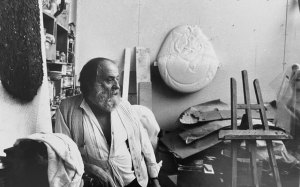 In honor of the centenary of the birth of César, the exhibition “César & César & César …” celebrates all important periods and styles of the major French sculptor’s work, organized in collaboration with Fondation César. The performative and participatory dimension of César’s public expansions and his participation in the action-spectacles of the Nouveaux réalistes, a possible prologue for relational aesthetics, have inevitably faded with time. His monumental oeuvre and his many public commissions—gleaming expansions, vibrant, painted compressions—could place him among the joyful or ironic celebration of society of Les Trente Glorieuses and industrial modernity, a radiant César. His bronzes and his late self-portraits dialogue with the traditions of sculpture and its masters, especially Picasso, and suggest melancholy, or even a certain morbidity that resonates with his early practice of collecting and recycling industrial materials and garbage, a gloomier, melancholy César. Info: Almine Rech, 64 Rue de Turenne, Paris, France, Duration: 12/6-31/7/2021, Days & Hours: Tue-Sat 11:00-19:00, www.alminerech.com
In honor of the centenary of the birth of César, the exhibition “César & César & César …” celebrates all important periods and styles of the major French sculptor’s work, organized in collaboration with Fondation César. The performative and participatory dimension of César’s public expansions and his participation in the action-spectacles of the Nouveaux réalistes, a possible prologue for relational aesthetics, have inevitably faded with time. His monumental oeuvre and his many public commissions—gleaming expansions, vibrant, painted compressions—could place him among the joyful or ironic celebration of society of Les Trente Glorieuses and industrial modernity, a radiant César. His bronzes and his late self-portraits dialogue with the traditions of sculpture and its masters, especially Picasso, and suggest melancholy, or even a certain morbidity that resonates with his early practice of collecting and recycling industrial materials and garbage, a gloomier, melancholy César. Info: Almine Rech, 64 Rue de Turenne, Paris, France, Duration: 12/6-31/7/2021, Days & Hours: Tue-Sat 11:00-19:00, www.alminerech.com
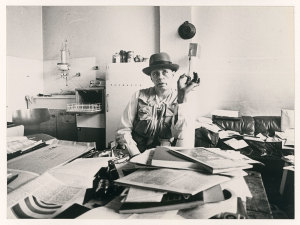 On November 20, 1985, Joseph Beuys gave one of his last public speeches at the Munich Kammerspiele as part of the series of events “Talking About One’s Own Country: Germany”. In it, he said of his development as an artist: “My path, strange as it is, took me by way of language; it did not originate from so-called artistic talent.” Whether thought, spoken, or written, in language Beuys saw a sculptural force through which each individual could participate in a re-ordering of society with their body, mind, and communicative behaviour—that is, to processes that he conceived as part of his sculptural theory. To mark the centenary of Joseph Beuys birth, the exhibition “Starting from Language” explores the power of language through chapters titled: Silence, Sounds, Terms, Writing, Secrecy, Legend, and Speaking. The exhibition encompasses more than 185 sculptures, drawings, installations, films, posters, and documents including the cycle “The secret block for a secret person in Ireland”. Info: Hamburger Bahnhof – Museum für Gegenwart – Berlin, Invalidenstrasse 50/51, Berlin, Germany, Duration: 13/6-19/9/2021, Days & Hours: Tue-Sat 10:00-18:00, Sun 11:00-18:00, www.smb.museum
On November 20, 1985, Joseph Beuys gave one of his last public speeches at the Munich Kammerspiele as part of the series of events “Talking About One’s Own Country: Germany”. In it, he said of his development as an artist: “My path, strange as it is, took me by way of language; it did not originate from so-called artistic talent.” Whether thought, spoken, or written, in language Beuys saw a sculptural force through which each individual could participate in a re-ordering of society with their body, mind, and communicative behaviour—that is, to processes that he conceived as part of his sculptural theory. To mark the centenary of Joseph Beuys birth, the exhibition “Starting from Language” explores the power of language through chapters titled: Silence, Sounds, Terms, Writing, Secrecy, Legend, and Speaking. The exhibition encompasses more than 185 sculptures, drawings, installations, films, posters, and documents including the cycle “The secret block for a secret person in Ireland”. Info: Hamburger Bahnhof – Museum für Gegenwart – Berlin, Invalidenstrasse 50/51, Berlin, Germany, Duration: 13/6-19/9/2021, Days & Hours: Tue-Sat 10:00-18:00, Sun 11:00-18:00, www.smb.museum
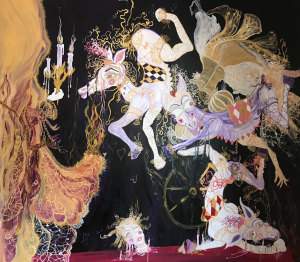 Lucile Littot presents her solo exhibition “Midnight Cinderella Sunrise Olympia”. Her universe strikes by its freedom, its singularity, its prosperity for exuberance, which is alternatively baroque, rococo, romantic, dreamlike, grotesque, caricatural, caustic, joyful and tragic. It is like a festival open to all plastic excesses, to a hybridization of forms and mediums, from painting to ceramics, in installations where nested and sprawling stories are intertwined. Glamorous and trash, Lucile Littot plays with hierachies and aesthetic categories to draw references from both the field of scholarly and popular culture. The ornamental excess in Lucile’s work resonates like an idealized and fantasized hypertrophy of the sublime. This particular disposition to play with mediums, objects and forma echoes his way of superimposing narratives into a narrative pudding. The objects in her installations then become the symbolic catalysts of multiple, intimate, personal, family, cultural, religious, historical references, with a predilection for tragic female destinies. Info: Allouche Benias, Kanari 1, Kolonaki, Athens, Greece, Duration: 17/6-17/7/2021, Days & Hours: Tue-Fri 11:00-19:00, Sat 11:00-17:00, https://allouchebenias.com
Lucile Littot presents her solo exhibition “Midnight Cinderella Sunrise Olympia”. Her universe strikes by its freedom, its singularity, its prosperity for exuberance, which is alternatively baroque, rococo, romantic, dreamlike, grotesque, caricatural, caustic, joyful and tragic. It is like a festival open to all plastic excesses, to a hybridization of forms and mediums, from painting to ceramics, in installations where nested and sprawling stories are intertwined. Glamorous and trash, Lucile Littot plays with hierachies and aesthetic categories to draw references from both the field of scholarly and popular culture. The ornamental excess in Lucile’s work resonates like an idealized and fantasized hypertrophy of the sublime. This particular disposition to play with mediums, objects and forma echoes his way of superimposing narratives into a narrative pudding. The objects in her installations then become the symbolic catalysts of multiple, intimate, personal, family, cultural, religious, historical references, with a predilection for tragic female destinies. Info: Allouche Benias, Kanari 1, Kolonaki, Athens, Greece, Duration: 17/6-17/7/2021, Days & Hours: Tue-Fri 11:00-19:00, Sat 11:00-17:00, https://allouchebenias.com
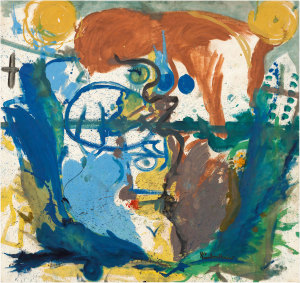 In the exhibition “Paintings by Helen Frankenthaler, 1952–1976”, fourteen paintings from the collection of the Helen Frankenthaler Foundation, are on show several of which have never been exhibited before. All are characterized by an extraordinary variety of line and color. The earliest of them, painted in 1952, before Frankenthaler’s breakthrough development of soak-stain painting later that year with “Mountains and Sea” is the work of an already mature artist: an invented panorama with suggestions of palm fronds and mountain peaks. The next belongs to a small group of canvases with drawn forms that Frankenthaler painted on her honeymoon with Robert Motherwell in the southwest of France. And four canvases from 1961 show her simplifying her drawing and making it more calligraphic, even as she continued to create figural as well as landscape references. Info: Gagosian, 20 Grosvenor Hill, London, England, Duration: 17/6-27/8/2021, Days & Hours: Mon-Sat 10:00-18:00, https://gagosian.com
In the exhibition “Paintings by Helen Frankenthaler, 1952–1976”, fourteen paintings from the collection of the Helen Frankenthaler Foundation, are on show several of which have never been exhibited before. All are characterized by an extraordinary variety of line and color. The earliest of them, painted in 1952, before Frankenthaler’s breakthrough development of soak-stain painting later that year with “Mountains and Sea” is the work of an already mature artist: an invented panorama with suggestions of palm fronds and mountain peaks. The next belongs to a small group of canvases with drawn forms that Frankenthaler painted on her honeymoon with Robert Motherwell in the southwest of France. And four canvases from 1961 show her simplifying her drawing and making it more calligraphic, even as she continued to create figural as well as landscape references. Info: Gagosian, 20 Grosvenor Hill, London, England, Duration: 17/6-27/8/2021, Days & Hours: Mon-Sat 10:00-18:00, https://gagosian.com
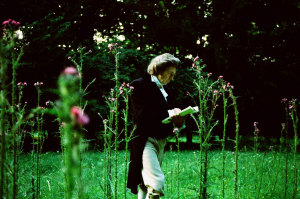 The film “The Three Little Pigs” (2012) by filmmaker Albert Serra, developed for documenta (13), as a monumental installation. This shows a portrait of Germany and an illustrated reflection on the shaping of history and our perception of it. To this end, the film follows the stories of three main characters from German cultural history: Goethe, Hitler, and Fassbinder. “The Three Little Pigs” is as complex and challenging as the question of what constitutes an understanding of history today—and in Germany in particular. Its connection between form and content make it clear that there is work to be done for an enlightened image of history, and the attempt to undertake the difficult positioning of a so-called “cultural nation” in the present means one thing above all: a constant task, a continual coming to terms with the past in the present. Info: Curator: Bettina Steinbrügge, Kunstverein in Hamburg, Klosterwall 23, Hamburg, Germany, duration: 19/9-15/8/2021, Days & Hours: Tue-Sun 12:00-16: 00, www.kunstverein.de
The film “The Three Little Pigs” (2012) by filmmaker Albert Serra, developed for documenta (13), as a monumental installation. This shows a portrait of Germany and an illustrated reflection on the shaping of history and our perception of it. To this end, the film follows the stories of three main characters from German cultural history: Goethe, Hitler, and Fassbinder. “The Three Little Pigs” is as complex and challenging as the question of what constitutes an understanding of history today—and in Germany in particular. Its connection between form and content make it clear that there is work to be done for an enlightened image of history, and the attempt to undertake the difficult positioning of a so-called “cultural nation” in the present means one thing above all: a constant task, a continual coming to terms with the past in the present. Info: Curator: Bettina Steinbrügge, Kunstverein in Hamburg, Klosterwall 23, Hamburg, Germany, duration: 19/9-15/8/2021, Days & Hours: Tue-Sun 12:00-16: 00, www.kunstverein.de
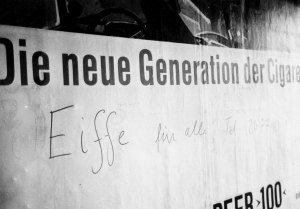 Peter Ernst Eiffe became famous during the protests of May 1968 in Hamburg for the absurdist slogans that he wrote with a felt-tip pen on everything from traffic signs to mailboxes, subway walls to department store price tags. This reached a climax when he drove into the Hauptbahnhof with his Fiat Topolino proclaiming the “Freie Eiffe-Republik”, leading to his institutionalization in the psychiatric ward of Ochsenzoll. The group exhibition “Peter Ernst Eiffe & Friends” shows documentation of Eiffe’s absurdist slogans and agit-prop activities in context with historic artistic positions of his time, while showing how the themes of this story are reflected in more recent artistic positions and forms of political protest today. Touching on the relationship between the urban subject and public space; the demand for art to take a position in public political life; the authority and function of the artist’s signature; and the use of satire, irony, and humor as a mode of critique. Info: Curator: Nicholas Tammens, Kunstverein in Hamburg, Klosterwall 23, Hamburg, Germany, duration: 19/9-15/8/2021, Days & Hours: Tue-Sun 12:00-16: 00, www.kunstverein.de
Peter Ernst Eiffe became famous during the protests of May 1968 in Hamburg for the absurdist slogans that he wrote with a felt-tip pen on everything from traffic signs to mailboxes, subway walls to department store price tags. This reached a climax when he drove into the Hauptbahnhof with his Fiat Topolino proclaiming the “Freie Eiffe-Republik”, leading to his institutionalization in the psychiatric ward of Ochsenzoll. The group exhibition “Peter Ernst Eiffe & Friends” shows documentation of Eiffe’s absurdist slogans and agit-prop activities in context with historic artistic positions of his time, while showing how the themes of this story are reflected in more recent artistic positions and forms of political protest today. Touching on the relationship between the urban subject and public space; the demand for art to take a position in public political life; the authority and function of the artist’s signature; and the use of satire, irony, and humor as a mode of critique. Info: Curator: Nicholas Tammens, Kunstverein in Hamburg, Klosterwall 23, Hamburg, Germany, duration: 19/9-15/8/2021, Days & Hours: Tue-Sun 12:00-16: 00, www.kunstverein.de
 Donna Huanca presents a series of new works commissioned by Ballroom Marfa in her exhibition “ESPEJO QUEMADA”. Huanca creates experiential installations that incorporate paintings, sculptures, video, scent and sound. The profound experiences and memories of Huanca’s first visit to Marfa in 2005 inspired the work in the exhibition. The artworks draw on visual, cultural, and mythological cues informed by feminism, decolonialism and the artist’s personal and familial histories, while simultaneously engaging with the biodiversity, geology, and dark skies of Far West Texas. The sky was particularly striking for Huanca–animated with cosmic and extraterrestrial forces while also revealing the natural rhythms of the sun and moon. This is Huanca’s first exhibition since the pandemic, uses mirrors as formal and metaphorical devices to respond to changing conditions. Info: Ballroom Marfa, 108 East San Antonio Street, Marfa, TX, United States, Duration: 26/6/2021-2/1/2022, www.ballroommarfa.org
Donna Huanca presents a series of new works commissioned by Ballroom Marfa in her exhibition “ESPEJO QUEMADA”. Huanca creates experiential installations that incorporate paintings, sculptures, video, scent and sound. The profound experiences and memories of Huanca’s first visit to Marfa in 2005 inspired the work in the exhibition. The artworks draw on visual, cultural, and mythological cues informed by feminism, decolonialism and the artist’s personal and familial histories, while simultaneously engaging with the biodiversity, geology, and dark skies of Far West Texas. The sky was particularly striking for Huanca–animated with cosmic and extraterrestrial forces while also revealing the natural rhythms of the sun and moon. This is Huanca’s first exhibition since the pandemic, uses mirrors as formal and metaphorical devices to respond to changing conditions. Info: Ballroom Marfa, 108 East San Antonio Street, Marfa, TX, United States, Duration: 26/6/2021-2/1/2022, www.ballroommarfa.org
